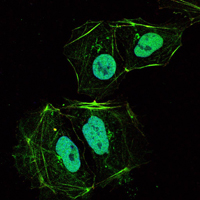OPG Monoclonal Antibody
- Catalog No.:YM0488
- Applications:WB;IF;FCM;ELISA
- Reactivity:Human
- Target:
- OPG
- Fields:
- >>Cytokine-cytokine receptor interaction;>>Osteoclast differentiation
- Gene Name:
- TNFRSF11B
- Protein Name:
- Tumor necrosis factor receptor superfamily member 11B
- Human Gene Id:
- 4982
- Human Swiss Prot No:
- O00300
- Mouse Swiss Prot No:
- O08712
- Immunogen:
- Purified recombinant fragment of human OPG expressed in E. Coli.
- Specificity:
- OPG Monoclonal Antibody detects endogenous levels of OPG protein.
- Formulation:
- Liquid in PBS containing 50% glycerol, 0.5% BSA and 0.02% sodium azide.
- Source:
- Monoclonal, Mouse
- Dilution:
- WB 1:500 - 1:2000. IF 1:200 - 1:1000. Flow cytometry: 1:200 - 1:400. ELISA: 1:10000. Not yet tested in other applications.
- Purification:
- Affinity purification
- Storage Stability:
- -15°C to -25°C/1 year(Do not lower than -25°C)
- Other Name:
- TNFRSF11B;OCIF;OPG;Tumor necrosis factor receptor superfamily member 11B;Osteoclastogenesis inhibitory factor;Osteoprotegerin
- Molecular Weight(Da):
- 46kD
- References:
- 1. Am J Hypertens. 2009 Nov;22(11):1167-70.
2. Am J Hum Genet. 2009 Nov;85(5):628-42.
- Background:
- The protein encoded by this gene is a member of the TNF-receptor superfamily. This protein is an osteoblast-secreted decoy receptor that functions as a negative regulator of bone resorption. This protein specifically binds to its ligand, osteoprotegerin ligand, both of which are key extracellular regulators of osteoclast development. Studies of the mouse counterpart also suggest that this protein and its ligand play a role in lymph-node organogenesis and vascular calcification. Alternatively spliced transcript variants of this gene have been reported, but their full length nature has not been determined. [provided by RefSeq, Jul 2008],
- Function:
- disease:Defects in TNFRSF11B are the cause of juvenile Paget disease (JPD) [MIM:239000]; also called hyperostosis corticalis deformans juvenilis or hereditary hyperphosphatasia or chronic congenital idiopathic hyperphosphatasia. JPD is a rare autosomal recessive osteopathy that presents in infancy or early childhood. The disorder is characterized by rapidly remodeling woven bone, osteopenia, debilitating fractures, and deformities due to a markedly accelerated rate of bone remodeling throughout the skeleton. Approximately 40 cases of JPD have been reported worldwide. Unless it is treated with drugs that block osteoclast-mediated skeletal resorption, the disease can be fatal.,function:Acts as decoy receptor for RANKL and thereby neutralizes its function in osteoclastogenesis. Inhibits the activation of osteoclasts and promotes osteoclast apoptosis in vitro. Bone homeostasis seems to depen
- Subcellular Location:
- Secreted.
- Expression:
- Highly expressed in adult lung, heart, kidney, liver, spleen, thymus, prostate, ovary, small intestine, thyroid, lymph node, trachea, adrenal gland, testis, and bone marrow. Detected at very low levels in brain, placenta and skeletal muscle. Highly expressed in fetal kidney, liver and lung.
- June 19-2018
- WESTERN IMMUNOBLOTTING PROTOCOL
- June 19-2018
- IMMUNOHISTOCHEMISTRY-PARAFFIN PROTOCOL
- June 19-2018
- IMMUNOFLUORESCENCE PROTOCOL
- September 08-2020
- FLOW-CYTOMEYRT-PROTOCOL
- May 20-2022
- Cell-Based ELISA│解您多样本WB检测之困扰
- July 13-2018
- CELL-BASED-ELISA-PROTOCOL-FOR-ACETYL-PROTEIN
- July 13-2018
- CELL-BASED-ELISA-PROTOCOL-FOR-PHOSPHO-PROTEIN
- July 13-2018
- Antibody-FAQs
- Products Images

- Western Blot analysis using OPG Monoclonal Antibody against HEK293 (1) and TNFRSF11B-hIgGFc transfected HEK293 (2) cell lysate.

- Immunofluorescence analysis of HL-60 cells using OPG Monoclonal Antibody (green). Blue: DRAQ5 fluorescent DNA dye.

- Flow cytometric analysis of HL-60 cells using OPG Monoclonal Antibody (green) and negative control (purple).



